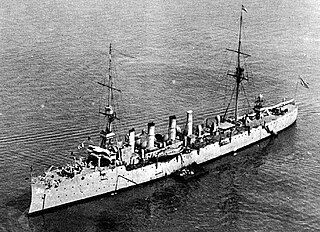
The fifth USS Boston was a protected cruiser and one of the first steel warships of the "New Navy" of the 1880s. In some references she is combined with Atlanta as the Atlanta class, in others as the Boston class.

The first USS Chicago was a protected cruiser of the United States Navy, the largest of the original three authorized by Congress for the "New Navy". One of the U.S. Navy's first four steel ships.

USS Dolphin (PG-24) was a gunboat/dispatch vessel; the fourth ship of the United States Navy to share the name. Dolphin's keel was laid down by Delaware River Iron Ship Building and Engine Works of Chester, Pennsylvania. She was launched on 12 April 1884, with Captain George Dewey in command, and commissioned on 8 December 1885 with Captain R. W. Meade in command. Dolphin was the first Navy ship to fly the Flag of the President of the United States during President Chester A. Arthur's administration, and the second Navy ship to serve as a presidential yacht.

USS Birmingham (CS-2/CL-2), named for the city of Birmingham, Alabama, was a Chester-class scout cruiser, reclassified a light cruiser in 1920. Entering service in 1908, the ship became known for the first airplane takeoff from a ship in history in 1910. During World War I, Birmingham escorted convoys across the Atlantic. The cruiser was decommissioned in 1923 and sold for scrap in 1930.

The first USS Astoria (SP-2005/AK-8) was a steel-hulled, coal-burning steam cargo ship of the United States Navy.

Union Iron Works, located in San Francisco, California, on the southeast waterfront, was a central business within the large industrial zone of Potrero Point, for four decades at the end of the nineteenth and beginning of the twentieth centuries.

USS Des Moines (C-15/PG-29/CL-17) was a protected cruiser of the Denver class in the United States Navy during World War I. She was the first Navy ship named for the city of Des Moines, Iowa.

USS Salem (CS-3/CL-3), Scout Cruiser No. 3, was a Chester-class scout cruiser of the United States Navy. She was the first Navy ship named for the city of Salem, Massachusetts.
USS Vixen may refer to the following ships of the United States Navy:

USS Isabel (SP-521), later PY-10, was a yacht in commission in the United States Navy as a destroyer from 1917 to 1920 and as a patrol yacht from 1921 to 1946.

The second USS Suwannee and third USS Mayflower was a United States Lighthouse Board, and later United States Lighthouse Service, lighthouse tender transferred to the United States Navy in 1898 for service as an auxiliary cruiser during the Spanish–American War and from 1917 to 1919 for service as a patrol vessel during World War I. She also served the Lighthouse Board and in the Lighthouse Service as USLHT Mayflower from 1897 to 1898, from 1898 to 1917, and from 1919 to 1939, and in the United States Coast Guard as the first USCGC Mayflower (WAGL-236) in 1939 and from 1940 to 1943 and as USCGC Hydrangea (WAGL-236) from 1943 to 1945.

The fifth USS Despatch (SP-68), later PY-8, originally USS Vixen (SP-68), was a yacht that served in the United States Navy as a tender from 1917 to 1919 and from 1920 to 1921.

USS Beaumere II (SP-444) was a United States Navy patrol vessel in commission from 1917 to 1919.

USS Satilla (SP-687) was a United States Navy patrol vessel in commission from 1917 to 1919.
Rear Admiral Newton Eliphalet Mason was a United States Navy officer. His career included combat in the Spanish–American War and service during World War I, significant experience in ordnance duty, and a very long tour as Chief of the Bureau of Ordnance.
This page is based on this
Wikipedia article Text is available under the
CC BY-SA 4.0 license; additional terms may apply.
Images, videos and audio are available under their respective licenses.












